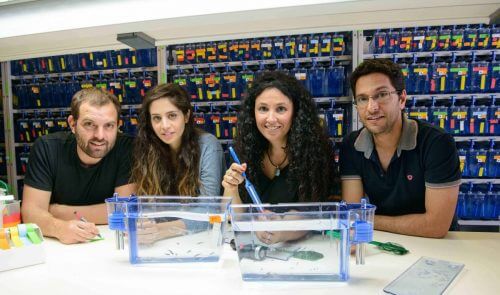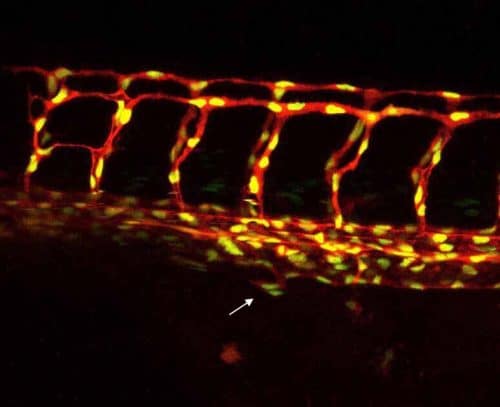The institute's scientists share in the global effort to understand how the stem cells know what type of cells to differentiate into. In a study they previously carried out in zebrafish, they discovered a pool of stem cells from which the lymphatic system develops. In the current study, it became clear that these cells also form, in a defined time window, the blood vessels of the digestive system.

Differentiation is not a simple story: over 5 billion cells make up the human body. Their diversity is huge, they are among hundreds of types and fulfill a series of roles. During the development of the embryo, and within a few days, many divisions are carried out in the cells, and they differentiate in a controlled way in order to build different tissues. But how is this complex differentiation coordinated? It is possible to liken the differentiation of cells and tissues to a family tree, where the main branch is the fertilized cell, from which every branching into a new branch constitutes a certain differentiation of the cells, and after many many branches the final product is reached. In most cases, as you move away from the first branch, the cells are more sorted. However, even in the "sorted" organism, stem cells remain (similar to the original cell), which are able to preserve the potential to create different types of cells.
Scientists all over the world share in the effort to deeply understand the various stem cells, and the essential factors that allow them to differentiate and produce a variety of tissues. This task is extremely complex, because stem cells in different tissues respond differently to differentiation and migration signals. Precisely because of this, deciphering the important signals sent for the differentiation of stem cells and the creation of active tissue is extremely important. for example, Dr. Karina Yaniv And the members of her group, in the Department of Biological Control at the Weizmann Institute of Science, discovered in a previous study a pool of stem cells that differentiate into cells of the lymphatic system. This discovery settled a debate that lasted more than 100 years regarding the origin of the lymphatic system, and allowed scientists to grow - for the first time - lymph cells in culture.
In a new study, which was recently published in the scientific journal Development, Dr. Yaniv, post-doctoral researcher Dr. Gideon Chen, and research student Julian Nissenbaum tried to understand what else the cells found in this pool are capable of doing. "We know that the endothelial cells, which are the cells that build the blood vessels and lymph, differentiate from unique stem cells, called 'angioblasts,'" says Dr. Yaniv. "But the process does not end there. The endothelial cells found in the brain are very different from the cells that make up the blood vessels of the liver or kidney, for example." But how do the stem cells know what type of cells to differentiate into? And when and how do these cells migrate to the tissue they are supposed to supply with oxygen and nutrients?

To answer these questions, the scientists marked cells in the blood vessels of zebrafish embryos - using a fluorescent molecule, which turns from green to red when ultraviolet light is irradiated on it. Thus, using a microscope and for several days, the scientists could follow the differentiating cells in the living embryo, and understand to which organ in the body the blood vessels migrate, and which signals determine the migration route.
The scientists discovered that the same pool of stem cells from which the lymphatic system develops is also the one from which other cells differentiate which migrate in a completely different direction, eventually forming the blood vessels of the digestive system. The members of the group found that, unlike cells destined to become lymph cells, cells destined to reach the liver, intestine or pancreas differentiate and find their way thanks to the presence of proteins from the BMP and VEGF families, which in a defined time window are expressed with high intensity along the migration path, thus allowing a certain pool of stem cells to differentiate to the cells of the lymphatic system, and only then to form blood vessels with completely different characteristics, which migrate to other target organs, such as the digestive system.
These findings may shed light on one of the great mysteries concerning the biology of blood vessels - from where blood vessels emerge in pathological conditions, such as cancer, which is characterized by the differentiation and migration of new blood vessels. To this end, Dr. Yaniv and the members of her group are now trying to locate in adult fish reservoirs of stem cells, such as those found in embryos. The scientists hope that in this way they will be able to better understand the biological processes that affect, among other things, the spread of cancer.

2 תגובות
Lorem Ipsum
It's still "over five billion" 🙂
It would be more correct to say "over 37 trillion"...
Are there 5 billion cells in the human body? How can this be if there are over 100 billion brain cells? In my opinion, there is a mistake here in several orders of magnitude. It seems to me that there are three orders of magnitude between a European billion (one thousand billion) and an American billion (one billion).
By the way, the information about tissue "migration" is very interesting, such as an arteriosclerosis that migrates into another tissue of another organ.